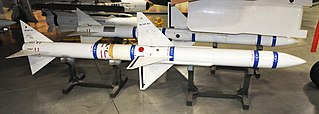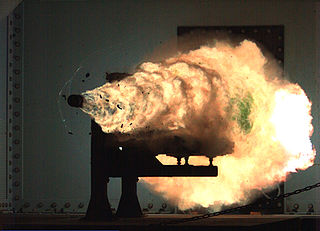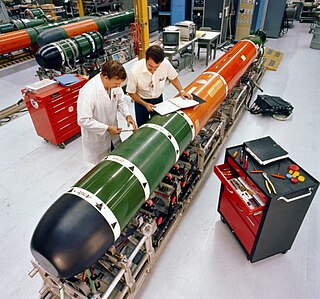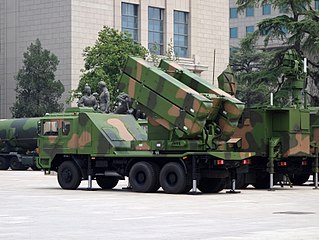Related Research Articles

The AIM-7 Sparrow is an American, medium-range semi-active radar homing air-to-air missile operated by the United States Air Force, United States Navy, and United States Marine Corps, as well as other various air forces and navies. Sparrow and its derivatives were the West's principal beyond visual range (BVR) air-to-air missile from the late 1950s until the 1990s. It remains in service, although it is being phased out in aviation applications in favor of the more advanced AIM-120 AMRAAM.

In physics, electromagnetic radiation (EMR) consists of waves of the electromagnetic (EM) field, propagating through space, carrying electromagnetic radiant energy. It includes radio waves, microwaves, infrared, (visible) light, ultraviolet, X-rays, and gamma rays. All of these waves form part of the electromagnetic spectrum.
A nuclear electromagnetic pulse is a burst of electromagnetic radiation created by a nuclear explosion. The resulting rapidly varying electric and magnetic fields may couple with electrical and electronic systems to produce damaging current and voltage surges. The specific characteristics of a particular nuclear EMP event vary according to a number of factors, the most important of which is the altitude of the detonation.
The microwave auditory effect, also known as the microwave hearing effect or the Frey effect, consists of the human perception of audible clicks, or even speech, induced by pulsed or modulated radio frequencies. The communications are generated directly inside the human head without the need of any receiving electronic device. The effect was first reported by persons working in the vicinity of radar transponders during World War II. In 1961, the American neuroscientist Allan H. Frey studied this phenomenon and was the first to publish information on the nature of the microwave auditory effect. The cause is thought to be thermoelastic expansion of portions of the auditory apparatus, although competing theories explain the results of holographic interferometry tests differently.

The United States Department of Energy (DOE) is a cabinet-level department of the United States Government concerned with the United States' policies regarding energy and safety in handling nuclear material. Its responsibilities include the nation's nuclear weapons program, nuclear reactor production for the United States Navy, energy conservation, energy-related research, radioactive waste disposal, and domestic energy production. It also directs research in genomics; the Human Genome Project originated in a DOE initiative. DOE sponsors more research in the physical sciences than any other U.S. federal agency, the majority of which is conducted through its system of National Laboratories. The agency is led by the United States Secretary of Energy, and its headquarters are located in Southwest Washington, D.C., on Independence Avenue in the James V. Forrestal Building, named for James Forrestal, as well as in Germantown, Maryland.

A railgun is a linear motor device, typically designed as a weapon, that uses electromagnetic force to launch high velocity projectiles. The projectile normally does not contain explosives, instead relying on the projectile's high speed, mass, and kinetic energy to inflict damage. The railgun uses a pair of parallel conductors (rails), along which a sliding armature is accelerated by the electromagnetic effects of a current that flows down one rail, into the armature and then back along the other rail. It is based on principles similar to those of the homopolar motor.

A directed-energy weapon (DEW) is a ranged weapon that damages its target with highly focused energy, including lasers, microwaves, particle beams, and sound beams. Potential applications of this technology include weapons that target personnel, missiles, vehicles, and optical devices. In the United States, the Pentagon, DARPA, the Air Force Research Laboratory, United States Army Armament Research Development and Engineering Center, and the Naval Research Laboratory are researching directed-energy weapons and railguns to counter ballistic missiles, hypersonic cruise missiles, and hypersonic glide vehicles. These systems of missile defense are expected to come online no sooner than the mid to late-2020s. The Electro-Magnetic Laboratory Rail Gun has been in testing since 2012.

The Gerald R. Ford class is a class of nuclear powered aircraft carriers currently being constructed for the United States Navy. The class, with a planned total of ten ships, will replace the Navy's current carriers on a one-for-one basis, starting with the lead ship, Gerald R. Ford replacing Enterprise (CVN-65), and then eventually taking the place of the existing Nimitz-class carriers. The new vessels have a hull similar to the Nimitz class, but introduce technologies since developed with the CVN(X)/CVN-21 program, such as the Electromagnetic Aircraft Launch System (EMALS), as well as other design features intended to improve efficiency and reduce operating costs, including sailing with smaller crews. This class of aircraft carriers is named after former US President Gerald R. Ford.

The Mark 48 and its improved Advanced Capability (ADCAP) variant are American heavyweight submarine-launched torpedoes. They were designed to sink deep-diving nuclear-powered submarines and high-performance surface ships.

The LY-60/FD-60/PL-10/HQ-6/6D/64 is a family of Chinese missiles developed by the Shanghai Academy of Science and Technology, largely based on the Italian Selenia Aspide missile - itself based on the American AIM-7 Sparrow missile. There are four versions of the basic design, three of which are surface-to-air and one air-to-air.

A spy ship or reconnaissance vessel is a dedicated ship intended to gather intelligence, usually by means of sophisticated electronic eavesdropping. In a wider sense, any ship intended to gather information could be considered a spy ship.

CATOBAR is a system used for the launch and recovery of aircraft from the deck of an aircraft carrier. Under this technique, aircraft launch using a catapult-assisted take-off and land on the ship using arrestor wires.

Naval Surface Warfare Center Crane Division is the principal tenant command located at Naval Support Activity Crane. NSA Crane is a United States Navy installation located approximately 35 miles southwest of Bloomington, Indiana, and predominantly located in Martin County, but small parts also extend into Greene and Lawrence counties. It was originally established in 1941 under the Bureau of Ordnance as the Naval Ammunition Depot for production, testing, and storage of ordnance under the first supplemental Defense Appropriation Act. The base is named after William M. Crane. The base is the third largest naval installation in the world by geographic area and employs approximately 3,300 people. The closest community is the small town of Crane, which lies adjacent to the northwest corner of the facility.

The Electro-Magnetic Laboratory Rail Gun is a 32-megajoule electro-magnetic laboratory rail gun being evaluated by the US Office of Naval Research (ONR) Naval Air Warfare and Weapons Department. The US Navy is pursuing development of the launcher system through two industry teams -- General Atomics and BAE Systems - to reduce risk in the program and to foster innovation in next-generation shipboard weapons. The same amount of energy is released by the detonation of 4.8 kg (11 lb) of C4.

The 9 cm PL kanon vz. 12/20 was a Czech anti-aircraft gun used during World War II. Those weapons captured after the German occupation of Czechoslovakia in March 1939 were taken into Wehrmacht service as the 9 cm Flak M 12(t). Some guns were reportedly captured in Yugoslavia and the Soviet Union as well. Twenty were in Czech service during the Munich Crisis in September 1938. Twelve were in German service between August 1943 and June 1944. According to Nebojša Đokić and Branko Nadoveza "Import of weapons for Army and Navy of Kingdom of SHS and Yugoslavia" 1 battery were apparently stationed in Bay of Kotor in Kingdom of Yugoslavia. Same authors in second part of book "Import of weapons for Army and Navy of Kingdom of SHS and Yugoslavia" in which import from Great Britain and Germany was analyzed, claim that 9 guns were installed on 6 Galeb-class minelayer minelayers of Royal Yugoslav Navy, 2 each on Sokol, Galeb and Orao and 1 on Jastreb Kobac and Gavran. Latter some of those guns (5?)were replaced with 8.35cm Škoda AA guns. It is possible that some of those guns after replacement on ships were put in service as ground anti aircraft battery.
Electronic harassment, electromagnetic torture, or psychotronic torture is a conspiracy theory that government agents make use of electromagnetic radiation, radar, and surveillance techniques to transmit sounds and thoughts into people's heads, affect people's bodies, and harass people. Individuals who claim to experience this call themselves "targeted individuals" (TIs). They claim they are victims of gang stalking and many have created or joined support and advocacy groups.
An electromagnetic pulse (EMP), also a transient electromagnetic disturbance (TED), is a brief burst of electromagnetic energy. Depending upon the source, the origin of an EMP can be natural or artificial, and can occur as an electromagnetic field, as an electric field, as a magnetic field, or as a conducted electric current. The electromagnetic interference caused by an EMP disrupts communications and damages electronic equipment; at higher levels of energy, an EMP, such as a lightning strike can physically damage objects such as buildings and aircraft. The management of EMP effects is a branch of electromagnetic compatibility (EMC) engineering.
Haiyang Shan is a Type 072III-class landing ship of the East Sea Fleet of the People's Liberation Army Navy.
The Long-Range Engagement Weapon (LREW) is a US Air Force concept for a next-generation beyond visual range air-to-air missile. Concept images shows a large, two-stage missile launched from an internal weapons bay of an F-22. There have been some reports that the LREW is too big to fit in the F-22 or F-35 internal weapons bay and is suited for the F-15EX or B-21. It is currently being developed by Raytheon. This program is separate from the AIM-260 JATM being developed by Lockheed Martin.
The AIM-260 Joint Advanced Tactical Missile (JATM) is an American beyond-visual-range air-to-air missile (BVRAAM) currently being developed by Lockheed Martin. Designed to address advanced threats, the missile is expected to replace the AIM-120 AMRAAM currently in US service. Initial launch platforms are expected to be the U.S. Air Force F-22 and the U.S. Navy F/A-18E/F, with integration with the F-35 planned afterwards.
References
- ↑ Navy SBIR Award Archived 2012-09-05 at archive.today (en)
- ↑ EPIC-ka broń Marynarki Wojennej - KopalniaWiedzy.pl (pl)